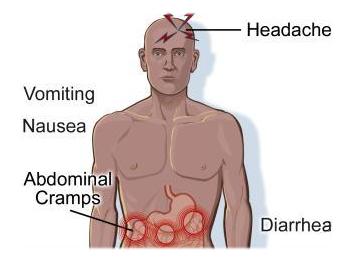Cholera is an infection caused by vibrio cholerae in the small intestine. Infection results in large amount of watery diarrhea and vomiting that causes loss of extracellular fluid.

Loss of extracellular fluid results in dehydration and electrolyte imbalance, if it is not controlled on time it results in death.
[sc name=”query”]
Cholera occurs in a patient after ingestion of organism, vibrio cholera, through food or water sources.
Safe drinking water and non contaminated food can prevent the occurrence of cholera.
Basics:
Vibrio cholera is a gram negative aerobic or facultative anaerobic bacillus. It is comma-shaped and varies in size from 1-3 micrometer in length and 0.5 to 0.8 micrometer in diameter
Vibrio cholerae enters the lumen of the gut, multiplies there secrete an anterotoxin which in turn secretes electrolytes and fluids from gut and produces diarrhea and vomiting. The incubation period of vibrio cholerae is 6 to 48 hours.
Fluid loss occurs in duodenum and upper jejunum. Colon is in a state of absorption as it is insensitive to toxin. Large volume of fluid is produced in upper intestine that over powers the absorptive capacity of lower bowel and results in severe diarrhea.
Enterotoxin do not invade the intestinal wall, they at locally.
[expand title=”Age/sex prevalence of cholera” expanded=”true”]
Individuals of any age and any sex can be affected by cholera.
Men, women, young, old all are prone to get affected.
[/expand][expand title=”Races affected by Cholera “]
Individuals of any race can be affected.
[/expand][expand title=”What Are The Causes Of Cholera?”]
Cholera is caused by gram-negative, comma shaped motile bacillus called vibrio cholerae.
The disease spreads by contamination of food or it may be water borne. Children are prone to infection in endemic areas.
[/expand][expand title=”What Are The Signs Indicates Presence Of Cholera?”]
• Rice water stool
• Painless diarrhea
• Vomiting
• Abdominal cramps
• Dehydration
• Leg cramps
• Sunken eyes
• Rapid heart rate
• Tiredness
• Low urine output
• Low blood pressure
• Dry skin and mouth.
[/expand][expand title=”Investigations of cholera”]
• Rectal swabs or stool examination is done to identify the bacteria.
• All food isolates must be tested for the production of cholera enterotoxin.
[/expand][expand title=”Treatment of cholera”]
• Oral rehydration therapy.
• Rice based solutions.
• Intravenous rehydration is given in case of severe dehydration.
• Ringer’s lactate with added potassium is given until diarrhea subsides.
[/expand][expand title=”Precautions To Be Taken In Cholera”]
• Eat thoroughly cooked food and consume it hot.
• Avoid undercooked food.
• Avoid eating salad.
• Avoid road side food or beverages.
• Maintain proper sanitation and water purification system.
• Consume lemon, onions, bland food and mint to the patient.[/expand][expand title=”Differential diagnosis of cholera”]
• Gastroenteritis
• E. coli infection
[/expand][expand title=”Prognosis of cholera”]
Prognosis depends on the severity of dehydration symptoms.
[/expand][expand title=”Homeopathic treatment for cholera”]
Arsenicum album
• Severe restlessness.
• Intense thirst.
• Violent vomiting of water.
• Icy coldness of the skin and clammy sweat.
• Stool scanty and watery.
Cuprum metallic
• Spasm in lower limbs spreads to upper limbs and muscles of abdomen and chest.
• Colic with nausea and vomiting
• Skin cold and blue.
• Epigastric distress and cramps.
Secale cornutum
• Brownish, flocculent, colorless stools.
• Aversion to heat or being covered.
• The stools are ejected with force.
• Vomiting without any effort, followed by weakness.
• Dry thick coating of the tongue.
• Unquenchable thirst.
Aconite
• Vomiting in greenish and bloody.
• Vomiting with profuse sweat and urination.
• Abdomen sensitive to touch.
• Discharges with collapse, anxiet and restlessness.
Camphora
• Blackish involuntary stool.
• Cholera with cramps in calves, coldness of body, anguish and great weekness.
• Patient collapses with cold mouth and tongue.
Carbo veg
• Abdomen greatly distended.
• Acrid corrosive moisture from rectum.
• Frequent, involuntary, cadaverous smelling stools.
• Bluish skin, cold limbs.
Cupric acid
• Violent spasmodic pain in abdomen.
• Violent tenesmus with diarrhea.
• Collapse and hippocratic face.
Ipecac
• Gripping pain at navel.
• Stool like frothy molasses.
• Constant nausea and vomiting.
• Profuse salivation.
Phosphoric acid
• Thirst for cold milk.
• Symptoms appears after sour food and drink.
• Aching in umbilical region.
• White, painless, involuntary stool with much flatus.
Veratrum alb
• Thirst for cold water but vomited as soon as swallowed.
• Copious nausea and vomiting, aggravted by drinking and least motion.
• Great weakness after vomiting.
• Stool on much straining cold sweat and exhaustion afterwards.
• Painful diarrhea.
[/expand]





